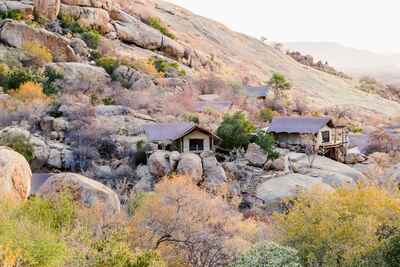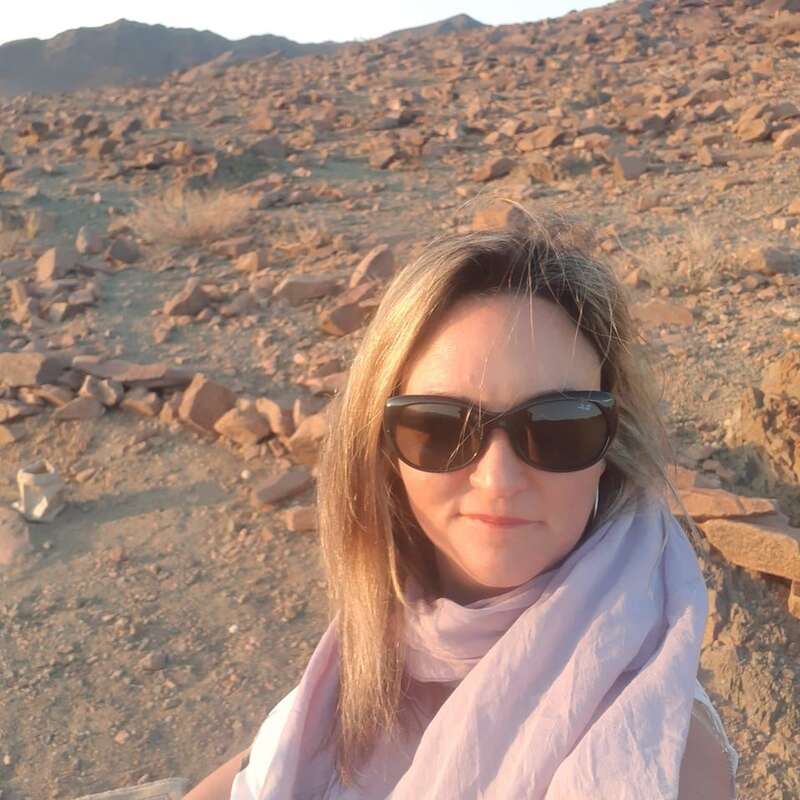About Ondudu Safari Lodge
Walking from Ondudu Safari Lodge is a superb way to explore the rugged Erongo Mountains.
By all means branch out on your own, with the aid of a trusty trail map, but do consider walking with one of the lodge’s guides, who as an added bonus have many a tale to tell of their homeland.
As a founder member of the Erongo Mountain Nature Conservancy, the lodge is committed to the preservation of this less-visited area, which is also renowned for excellent birding – and stunning views.
Almost every aspect benefits from those views: the open-plan decks by a small waterhole; the comfortable tented chalets dotted among the rocks; even the stone-walled showers.
With a popular birdbath by the dining area, birders don’t need to venture far, either, to spot the rosy-faced lovebirds and black-throated canaries that are notable Erongo inhabitants – along with the endemic (and herbivorous) dassie rats.
The strong sense of place filters down into the lodge’s décor, its stone-and-thatch building adorned with African baskets and a bar in the shape of a dug-out canoe. Just 3–4 hours’ drive from Windhoek Airport, and with relaxed, friendly staff, it adds up to an enticing proposition.
Stop press: In May 2020 after many years of being one of our most popular lodges in Namibia, Erongo Wilderness Lodge sadly closed. However it reopened as Erongo Wild and has subsequently been renamed Ondudu Safari Lodge - we hope to have one of the team visit before the end of 2024 - watch this space for further updates or do call us for the latest information. (The team from the old Erongo Wilderness Lodge continue to run their sister property Ai Aiba in the same area.)
Our view
Ondudu is a very comfortable tented lodge in a scenic area, with good guiding, service and food. It's a birders' paradise and a great place to stretch your legs on one of the numerous walking trails. The lodge is most often used as the final stop on a Namibian adventure, being only a 3–4-hour drive from Windhoek international airport on good roads.
Accommodation
12 tented chalets
Children
Best for 5+
Open
All year
Activities

4WD Safari

Birdwatching

Cultural excursion

Guided walking safari

Private activities

Self-guided walking
Traveller reviews of Ondudu Safari Lodge
417 real, un-edited reviews from Expert Africa's travellers.
Arrived 16 Nov 2024, 1 nights
"Ondudu Safari Lodge review"
Overall rating: Good
Arrived 1 Oct 2024, 2 nights
"Ondudu Safari Lodge review"
Overall rating: Excellent
Arrived 4 Oct 2024, 2 nights
"Ondudu Safari Lodge review"
Overall rating: Excellent
Arrived 31 Aug 2024, 2 nights
"Ondudu Safari Lodge review"
Overall rating: Good
Arrived 13 May 2024, 1 nights
"Beautiful views of the Erongo Mountains"
Overall rating: Excellent
Arrived 31 Jul 2023, 1 nights
"Erongo Wild review"
Overall rating: Good
Arrived 18 Nov 2019, 1 nights
"Erongo Wilderness Lodge review"
Overall rating: Good
Arrived 22 Oct 2019, 1 nights
"Erongo Wilderness Lodge review"
Overall rating: Excellent
Arrived 6 Oct 2019, 2 nights
"Beautiful Lodge in a stunning location"
Overall rating: Excellent
Arrived 7 Oct 2019, 1 nights
"Something a little different"
Overall rating: Excellent
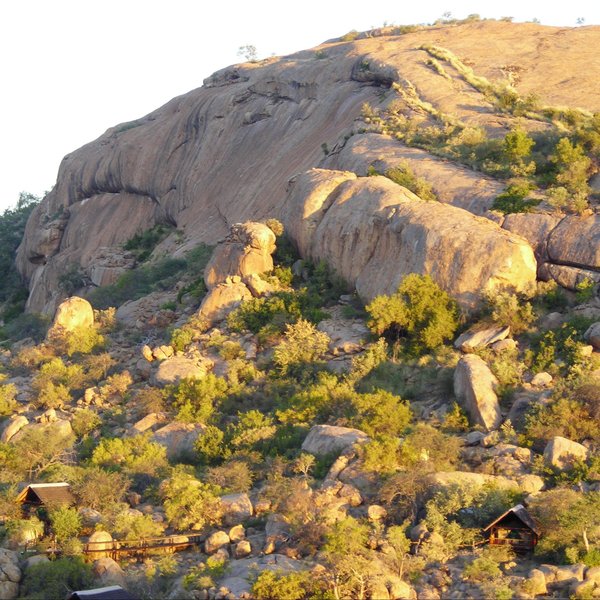
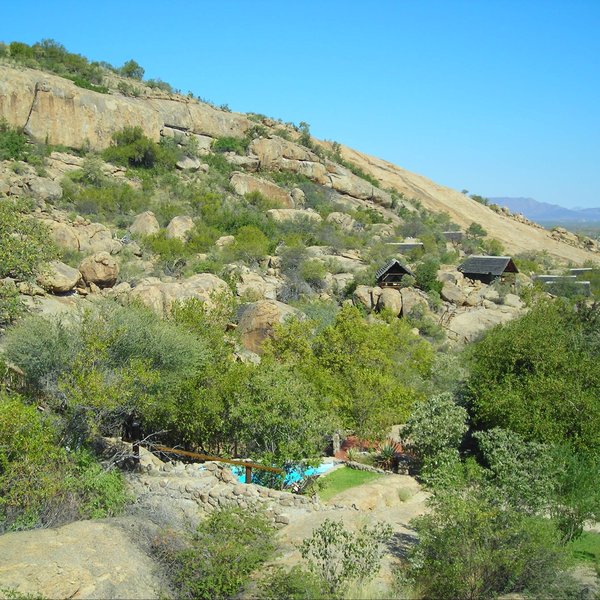
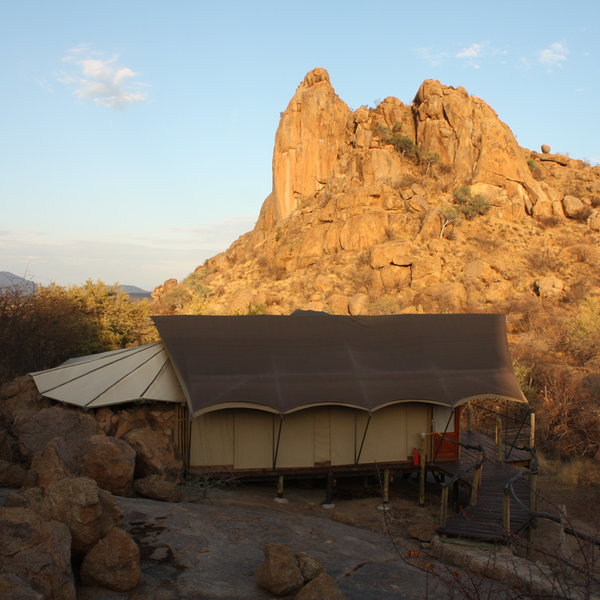
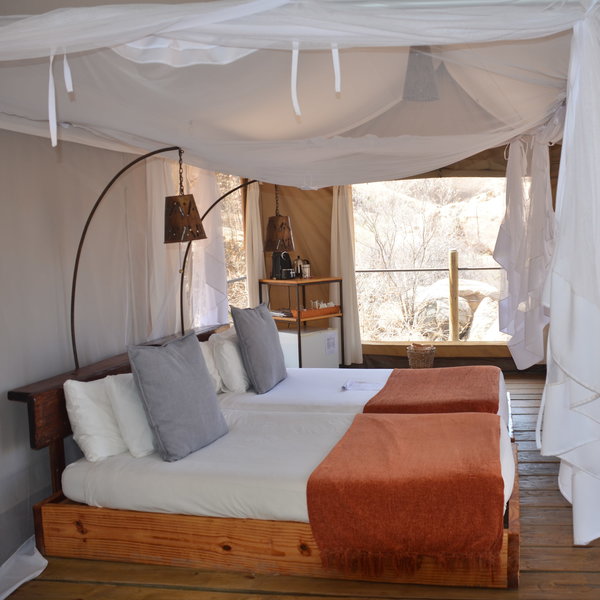
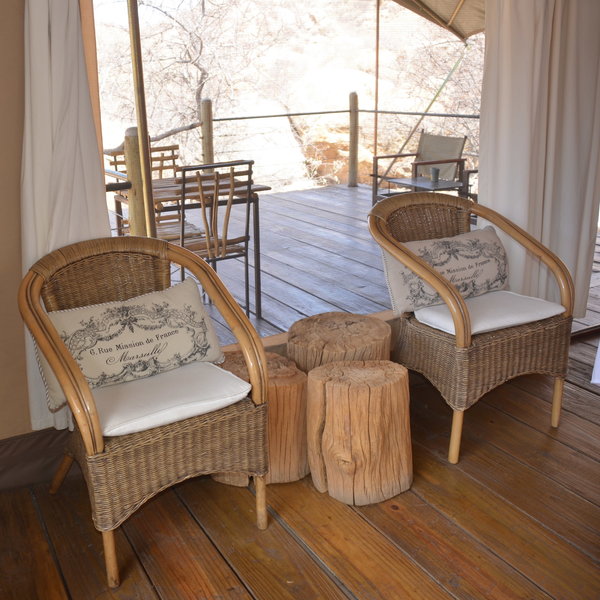
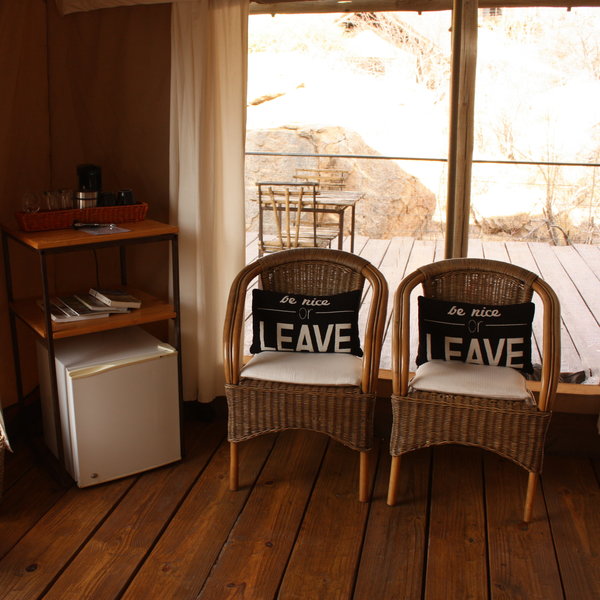
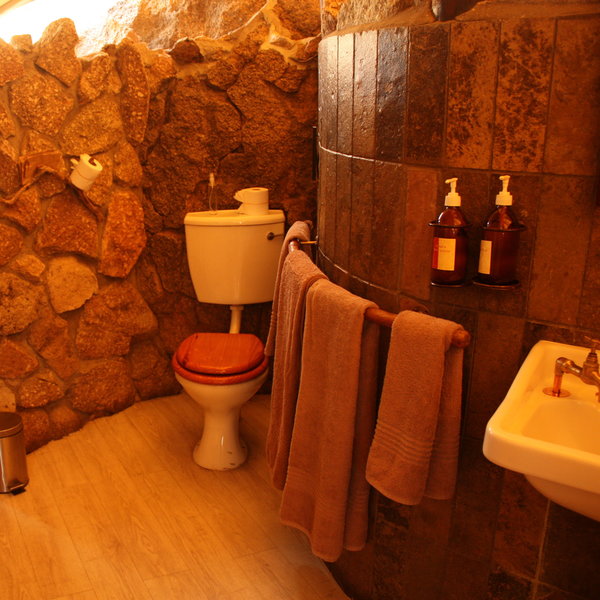
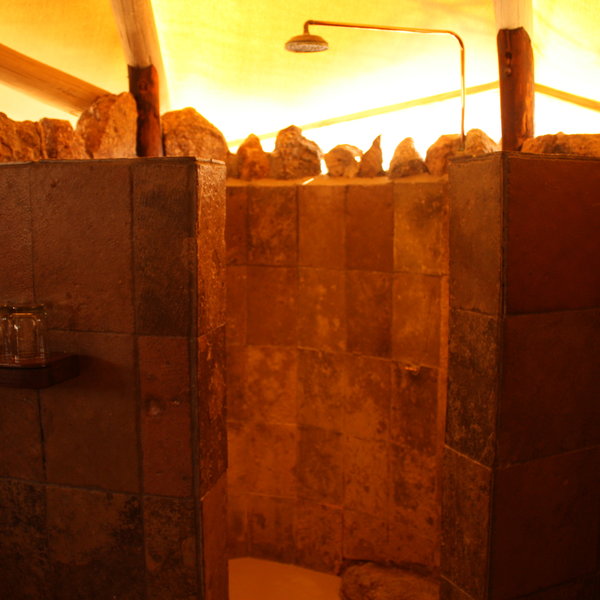
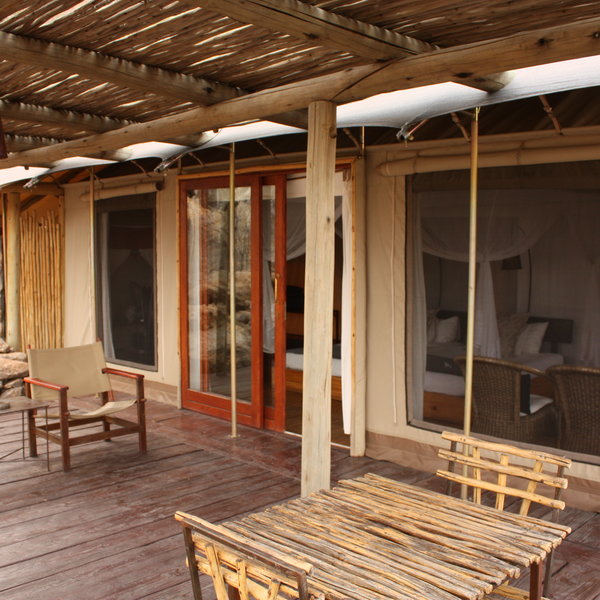
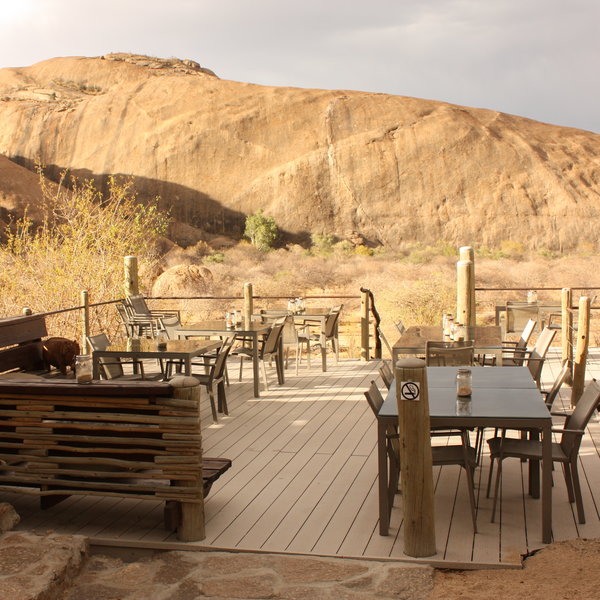
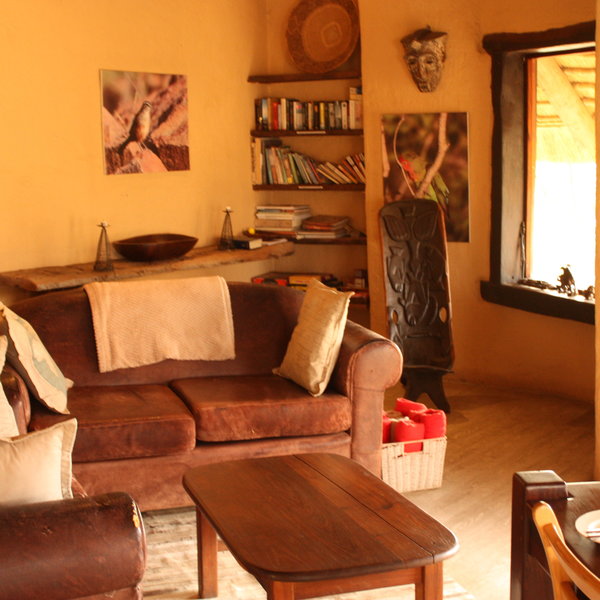
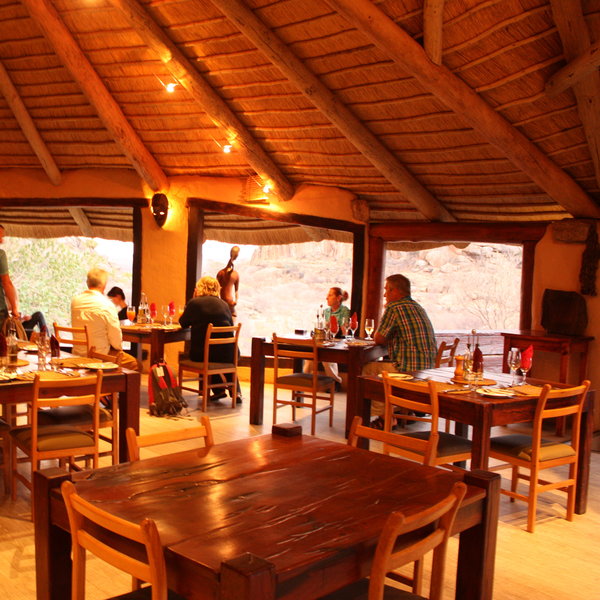
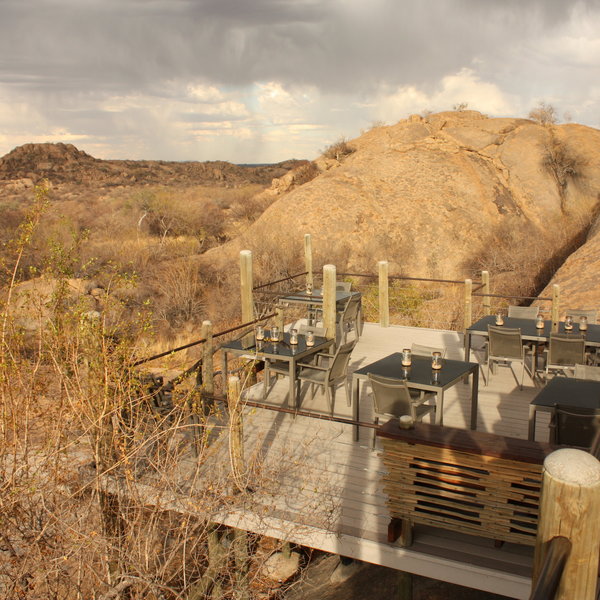
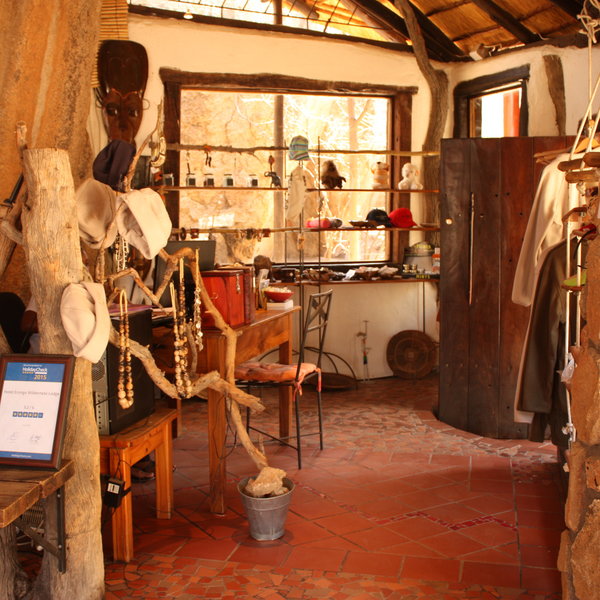
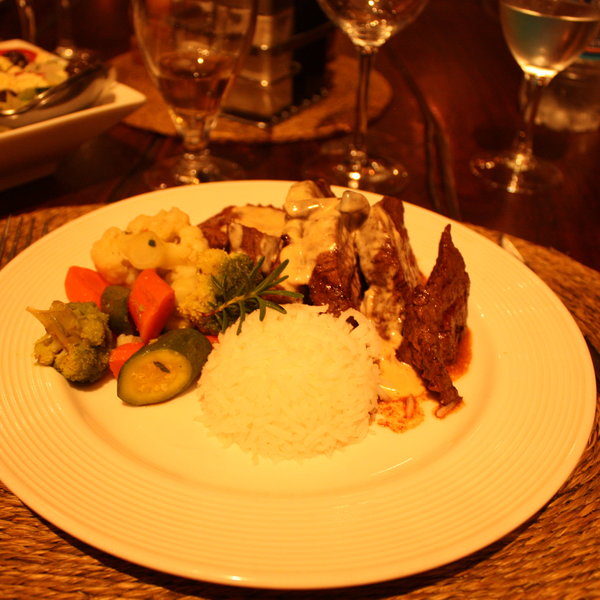
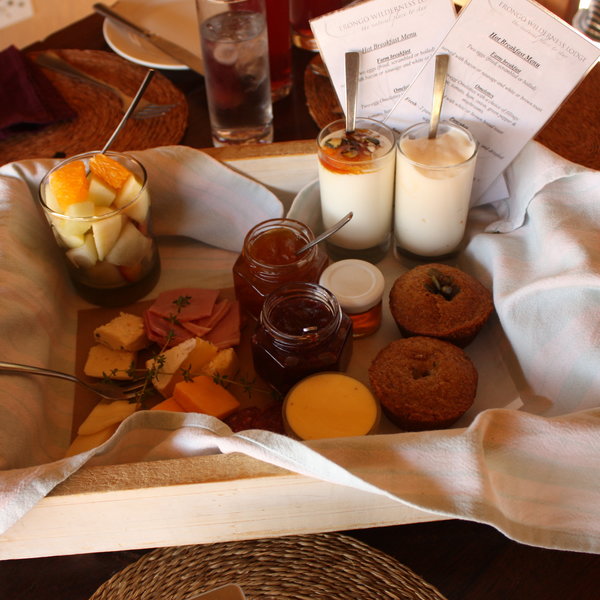
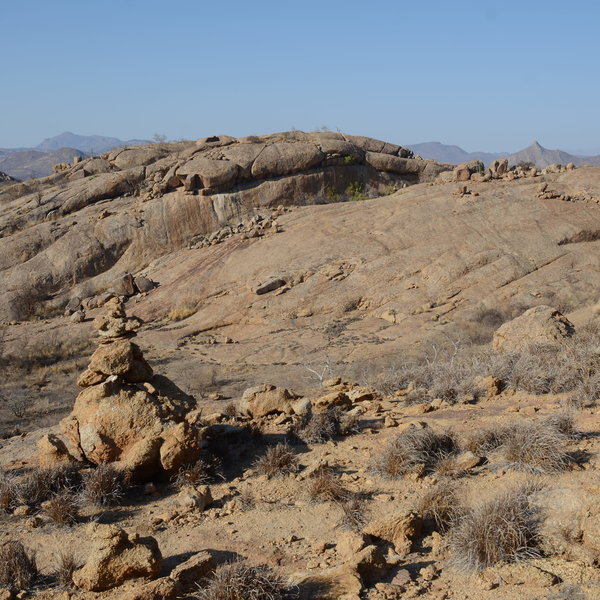
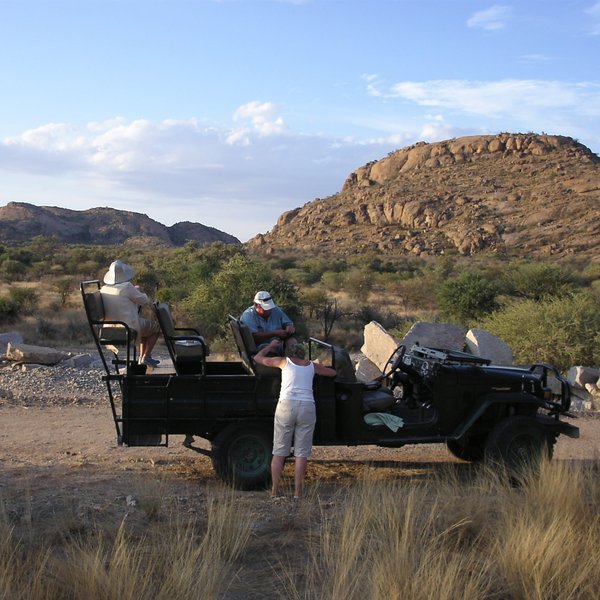
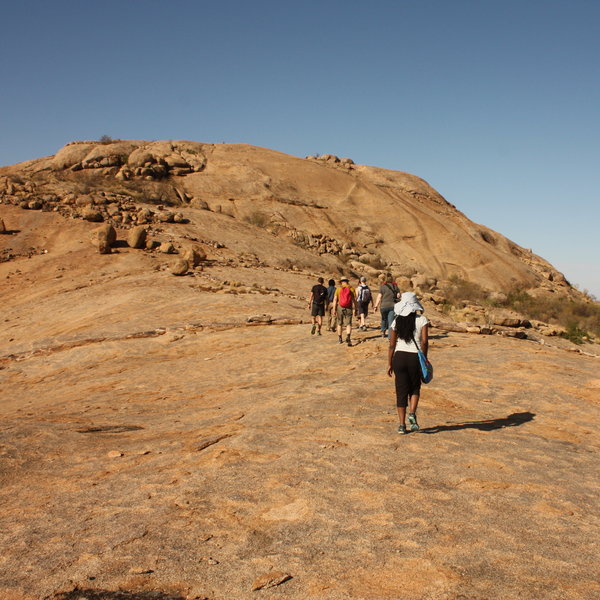
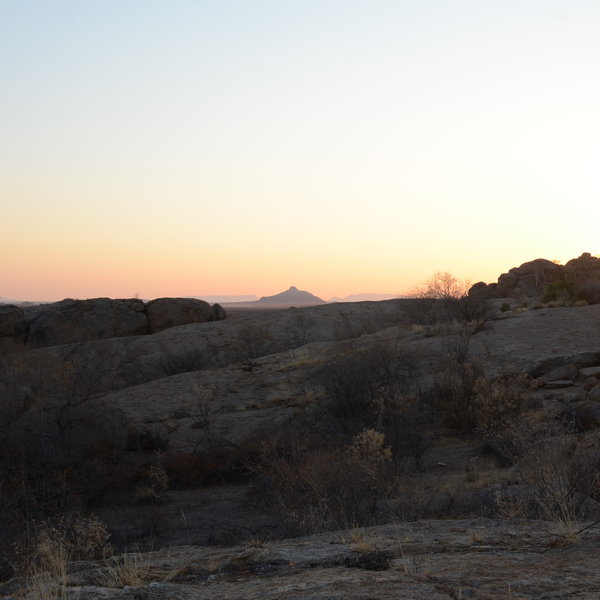
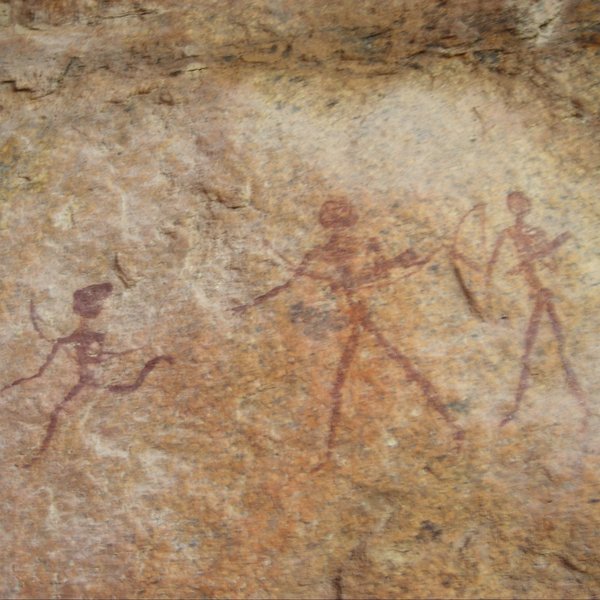
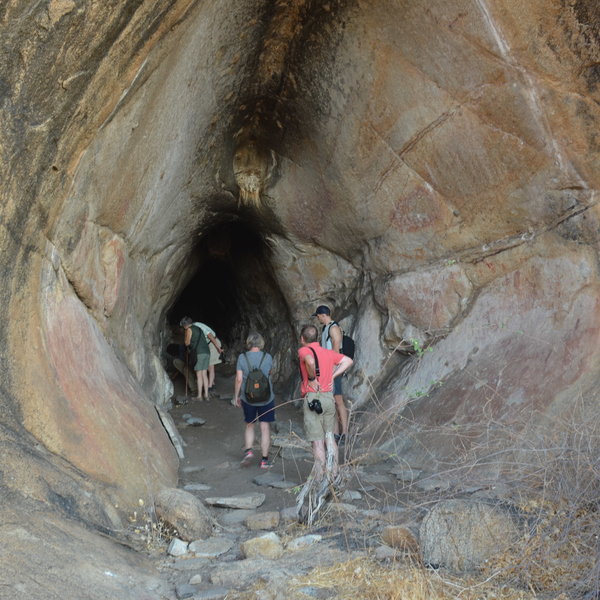
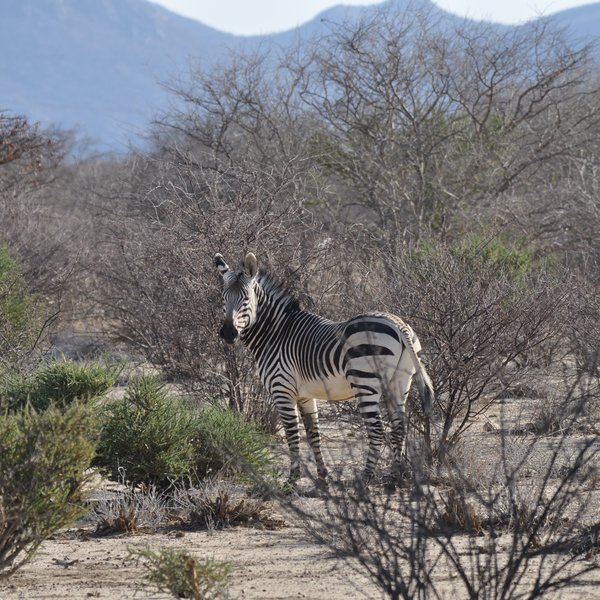
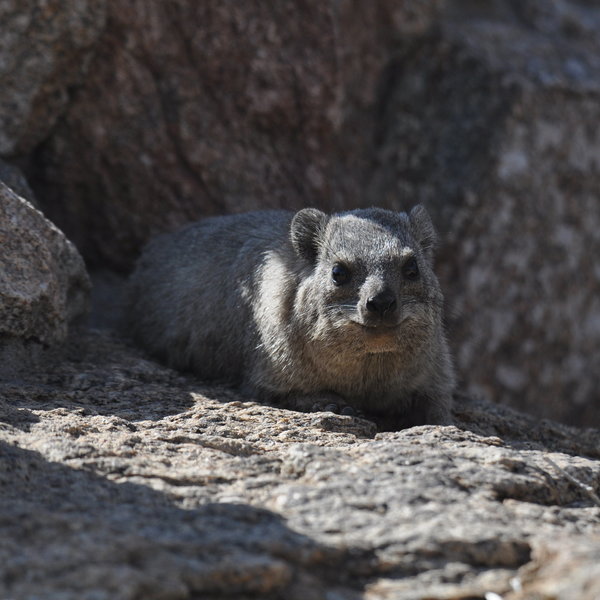
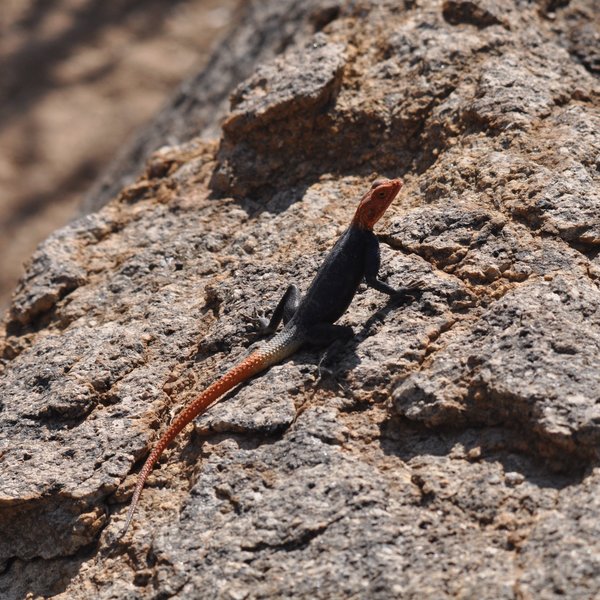
Expert Africa's gallery
When we travel we take lots of photos ourselves to give you a real and un-edited view of the safaris. See our 35 pictures and 1 videos of Ondudu to get the candid view.
View galleryOndudu Safari Lodge: Our full report
Amidst the rugged kopjes of the Erongo Mountains, Ondudu Safari Lodge lies near an ancient volcanic crater.
Just west of Omaruru, the lodge is a founder member of the 2,000km² Erongo Mountain Nature Conservancy, which brings together 30 private landowners in an effort to conserve this diverse area, known locally for excellent birding and walking. There are also rare and endemic species of flora and fauna here, along with Bushman rock paintings.
Ondudu Safari Lodge is a friendly, relaxed place with superb views from its 12 comfortable tented chalets. Built up on raised platforms, these are tucked amongst the boulders, offering seclusion and privacy. (Wooden walkways and steps lead to most of the chalets, making access difficult for guests with limited mobility, although there are a couple of chalets, closer to the main area, which have easier access.) Glass sliding doors lead out onto a large, partially covered wooden deck where you'll find a couple of director's chairs and a rustic table flanked by two wooden chairs.
Inside, Ondudu Safari Lodge's chalets are spacious, with polished wooden floors. Insect-proof netting at the windows allows air to flow freely through the tented walls, but canvas flaps can be zipped up to cover the netting if required. Twin beds, each on a wooden base with a wooden headboard, are made up with crisp white linen, with a metal reading lamp suspended above and mosquito nets around them. There's an open hanging rack, a luggage rack, two wicker chairs, tea- and coffee-making facilities, a flask of drinking water and a small fridge, which is stocked on request. Tissues, candles and a torch are also provided and each tent has a digital safe and power point.
A solid door at the rear of each tented chalet opens into an en-suite bathroom. Partially built into the bare rock behind the tent, this has a very natural feel, with stone walls separating the shower from the basin and toilet, and a gap between the wall and the roof, allowing great views from the shower! There's hot and cold running water, and toiletries in the form of liquid soap, shampoo/conditioner/shower gel, body lotion and natural insect-repellent cream are provided.
In room number 6, the honeymoon tent, you’ll find a double bed instead of twins, and a larger private deck with a plunge pool, chairs and an umbrella.
There is also a two-tented suite, ideal for a family or a group of friends travelling together. Similar in style to the other chalets, it is made up of two separate en-suite tents around a central kitchen and lounge area, and a veranda that stretches around half of the unit with stunning views of the surrounding hills. We understand that this unit might be given its own private plunge pool in the future. Although the suite has been designed as a self-catering option, guests staying here are also welcome to eat at the main lodge.
Raised wooden walkways and natural stone steps connect all the chalets to Ondudu's main area: a stone and thatched building atop a separate hill. Decorated with African basketwork and masks, it incorporates a central fireplace, an open-plan dining area/lounge with a selection of books, and a bar in the shape of a dug-out canoe. Make yourself comfortable on one of the big leather sofas or matching chairs, or take in the mountain views from one of two outside decks, one with a firepit, and both overlooking a small waterhole. There is a birdbath beside the dining area where rosy-faced lovebirds, red-eyed bulbuls, black-throated canaries and white-tailed shrikes are often seen, as well as rock dassies (hyrax) and the endemic dassie rats vying for drinking space.
Built into the rocks is a small swimming pool with a grassed area and sundowner deck, a good spot to relax in the afternoon after an energetic morning walk. A well-stocked curio shop doubles as the reception area for arriving and departing guests.
Activities at Ondudu Safari Lodge focus on walking – which is the best way to explore this beautiful area. You can set out on your own, or join a walk with one of the lodge's knowledgeable guides. There are two walks each morning: one at 7.00am lasting 2–2.5 hours, and an earlier one, at 6.00am, of 3–3½ hours – which we thoroughly enjoyed on a previous visit in 2016. In the evening, there are sundowner walks to a nearby vantage point where the views are spectacular. Note, though, that this route would be challenging for the less sure of foot or for those with vertigo, and that sundowner drinks cost extra.
The longer morning walk leads up into the rocky outcrops and over the granite whalebacks, offering stunning views of the surrounding landscape and the lodge below. Most of the lodge’s guides have grown up in the area, and they have some fascinating stories to share.
On our last visit in September 2018 we decided to skip the early departure and take on one of the self-guided walking trails. These vary from the 1.8km dassie trail to the lengthy 9.6km pangolin trail. Following the trail map proved easy and there are lots of markers on the route, but for safety reasons you should always tell reception when you are setting out.
An afternoon nature drive in an open 4WD vehicle is also available at additional cost, to include all drinks. While the Erongo Conservancy is home to a variety of wildlife, including steenbok, kudu, oryx, klipspringer, Damara dik-dik, Hartmann's mountain zebra, giraffe, warthog and, since 2008, black rhino, the densities are low and this is definitely a nature drive rather than a game-viewing experience. Birders should be on the look out for black eagles, Monteiro's hornbill and Hartlaub's spurfowl, among many other species, but for most the highlight of the drive is visiting Paula's Cave. Reached by a relatively steep walk up a trail skirting along the rocky hillside, this features some interesting Bushman rock art depicting various animals and people.
Geographics
- Location
- Central Highlands, Namibia
- Ideal length of stay
- Two or three nights for keen walkers. If you're not visiting Damaraland, then Ondudu Safari Lodge makes a perfect stop between Swakopmund and Etosha; alternatively, stop here on your way between Etosha and Windhoek
- Directions
- Ondudu is around 10km west of Omaruru along the D2315, from where it is signposted along a gravel road.
- Accessible by
- Self-drive
Food & drink
- Usual board basis
- Half Board
- Food quality
- During our visit to Erongo in September 2018 we found the food to be as well-presented and excellent as on our previous visits.
In the early morning, tea, coffee and rusks or muffins are available before the guided walks.
Brunch, which is timed to coincide with guests’ return from the guided walks, is brought to the table on a small tray with a selection of fresh fruit, yoghurts, muffins and a plate of cold meat and cheese. A cooked breakfast is also available. We were offered a selection of eggs, omelettes with different fillings, and sweet or savoury pancakes.
At around 3.00pm, before the afternoon activities, afternoon tea is served, with tea/coffee and delicious homemade cake.
Dinner is a three-course meal with a starter, main course and dessert. Ours started with butternut soup and freshly made bread rolls. A choice of oryx steak or herb-crusted fish followed, both served with steamed vegetables and mashed potatoes. For dessert we tucked into a lemon sponge pudding, a nice crisp finish to the meal. - Dining style
- Individual Tables
- Dining locations
- Indoor Dining
- Further dining info, including room service
- There is no room service
- Drinks included
- Tea and coffee are included, but other drinks are not. The tap water is considered safe to drink.
Special interests
- Birdwatching
- Ondudu Safari Lodge should be high on the list of those visiting Namibia for a birding holiday. The rocky landscape is home to a surprising proliferation of avifauna, including several near endemics and exploring the area on foot is a great way to spot them.
- See ideas for Birdwatching in Namibia
- Walking
- The walking opportunities from Ondudu Safari Lodge rank amongst the best in Namibia. The vast rocky landscape is easily explored on guided or self-guided walking trails and the views are certainly worth the effort.
- See ideas for Walking in Namibia
Children
- Attitude towards children
- The lodge welcomes children of all ages.
- Property’s age restrictions
- There is no age restriction
- Special activities & services
- There are no special activities for children
- Equipment
- The lodge has one cot for infants.
- Generally recommended for children
- Yes, as long as they are sufficiently mature to take part in the walks.
- Notes
- There's a rocky, fairly steep climb to the individual chalets, so parents need to keep a close eye on children at all times. The pool is also unfenced and unguarded so children require constant supervision.
Our travellers’ wildlife sightings from Ondudu
Since mid-2018, many of our travellers who stayed at Ondudu Safari Lodge have kindly recorded their wildlife sightings and shared them with us. The results are below. Click an animal to see more, and here to see more on our methodology.

23% success

17% success

3% success

3% success

0% success

0% success

0% success

0% success

0% success

0% success

0% success

0% success
Communications
- Power supply notes
- Power is always on and generally reliable, but there is a back-up generator too. Plugs are South-African style with three round pins (230 volts).
- Communications
- Cellphone reception is available in the dining area, and in some of the tented chalets, though the lodge's location in a valley and amongst boulders makes this a little erratic. WiFi is available in the main area, and there is a guest computer for internet access in the curio shop.
- TV & radio
- None
- Water supply
- Borehole
- Water supply notes
- The showers are plumbed, the toilets are flush and there is plenty of hot water.
Sustainability
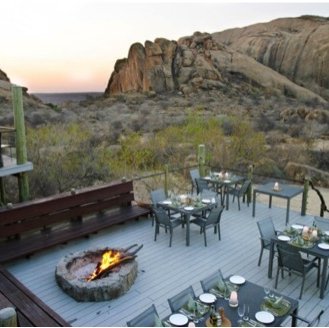
It’s the simple things that matter
In a special hideaway in the valley of Erongo Mountains perches Ondudu Safari Lodge. Sitting peacefully amongst rocks and trees, the luxurious chalets harmonise with the surroundings. Outside, the pool lures guests to relaxation and rejuvenation. Pool towels are provided- as a personal touch, but guests are encouraged to keep them during their stay and reuse like home.
Tour guides invite guests for nature walk and share stories on the stunning plant life and its different uses – medicinal or edible. Provided with the freedom of walks, guests are encouraged to engage in adventurous hikes or gentle strolls depending on their daily routine.
In an attempt to preserve the beauty of the local area, both guests and staff are advised to follow simple steps such as disposing of used plastic water bottles in designated recycling bins, which are then collected and sent to local recycling plants.
Each chalet has its own private en-suite and excess water is re-used for cleaning the floors. The atmospheric solar jar lights help guests unwind at dinner time, whilst admiring the impressive range of magnificent birds frequenting the restaurant’s nearby water points. A rewarding feeling is created when donating to the lodge’s endorsed conservation fund - the Erongo Mountain Nature Conservancy whose mission is to protect the Black-faced Impala and Black Rhino. The future will see the lodge becoming more reliant on solar power, with the introduction of solar panels and solar heaters already underway. Erongo Wilderness Lodge is the perfect destination for those who wish to act upon conservation of the local environment.
See more great sustainability projects in Namibia
Health & safety
- Malarial protection recommended
- No
- Medical care
- There is a first-aid kit on site, and a doctor and small hospital in Omaruru (13km away). In an emergency, guests would be airlifted to Windhoek..
- Dangerous animals
- Low Risk
- Security measures
- There is an armed security guard on duty at night.
- Fire safety
- There is a fire extinguisher outside each tented chalet and in the dining/kitchen area.
Activities
4WD Safari
Birdwatching
Cultural excursion
Guided walking safari
Private activities
Self-guided walking
Extras
- Disabled access
- On Request
- Laundry facilities
- A laundry service is available for an extra charge.
- Money
- There are electronic combination safes in each tent. Ondudu doesn't offer a foreign exchange service.
- Accepted payment on location
- Payment is accepted in cash in Namibian dollars and South African rand, or by Visa or Mastercard.
Plan and book your trip with Expert Africa
All of our trips are tailor-made, so we'll always adapt them to suit you. Talk to an Expert and let us plan and arrange your perfect trip.

Talk to an Expert
Call or email us now! We’ll match you with the Specialist in our team who is best suited to help you. Then together we can start planning your trip.

Set up your itinerary
Based on our experience and your ideas, your specialist will create a detailed, costed itinerary. We’ll refine it together, until we have a trip that you’re perfectly happy with.

Prepare for your trip
The same Specialist will make the seamless arrangements for your trip, send you detailed travel documents, and be available to answer any questions before you depart.

Travel with peace of mind
After you set off, you’ll be cared for by our partners in Africa, most of whom have worked with Expert Africa for decades. And if you ever need us urgently, we’re available 24/7.

When you return
We love to learn about your trip, and so will always be grateful if you’ve the time to give feedback to your Specialist when you return.
Ondudu Safari Lodge's location
Look closer at the environment and surroundings of Ondudu.
Other lodges in Central Highlands
Alternative places to stay in this same area.
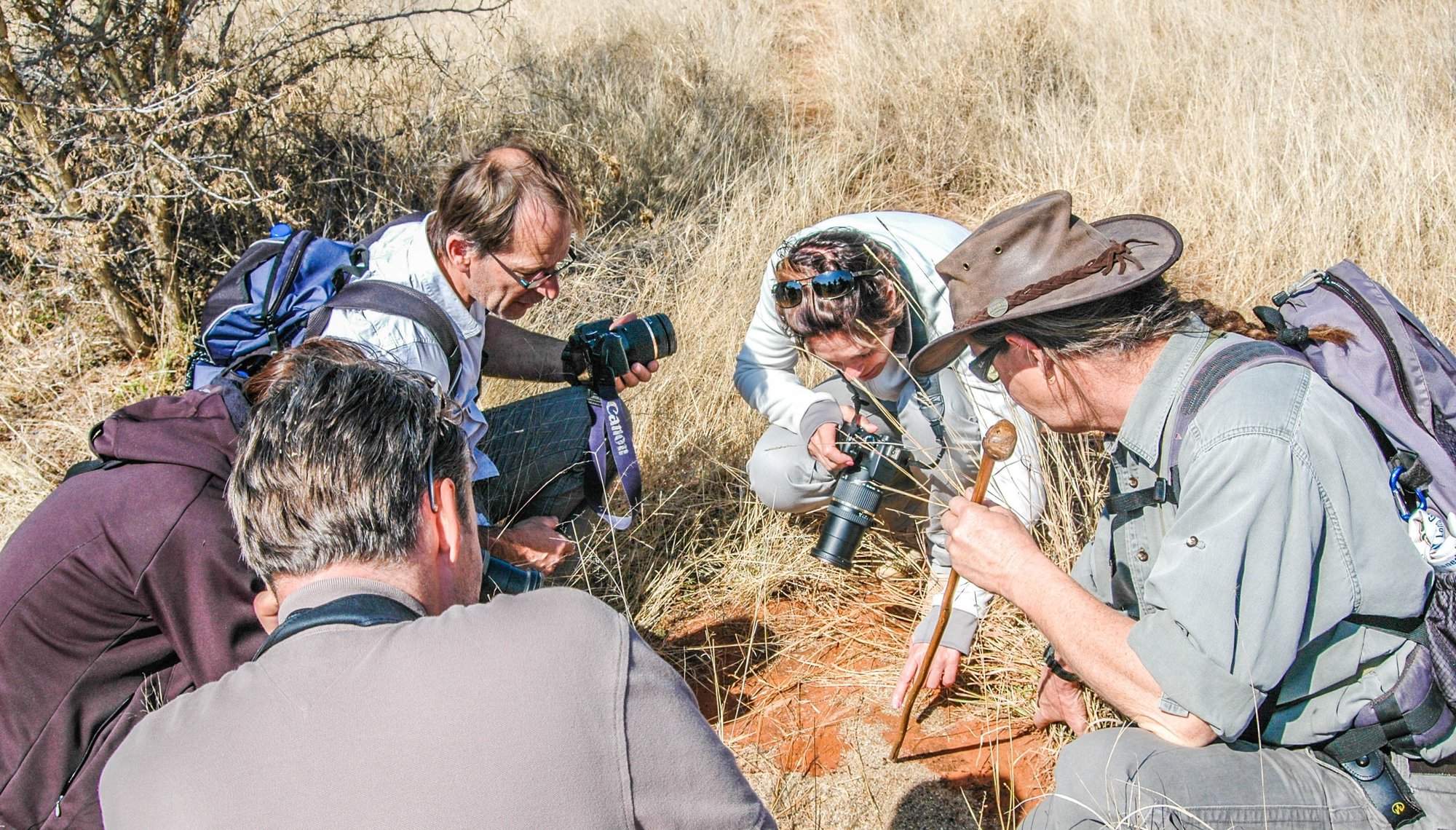
Mundulea Reserve
The rustic Mundulea Bushcamp offers superb and varied walking in the company of a top-class guide on a reserve that features many endangered or endemic species.
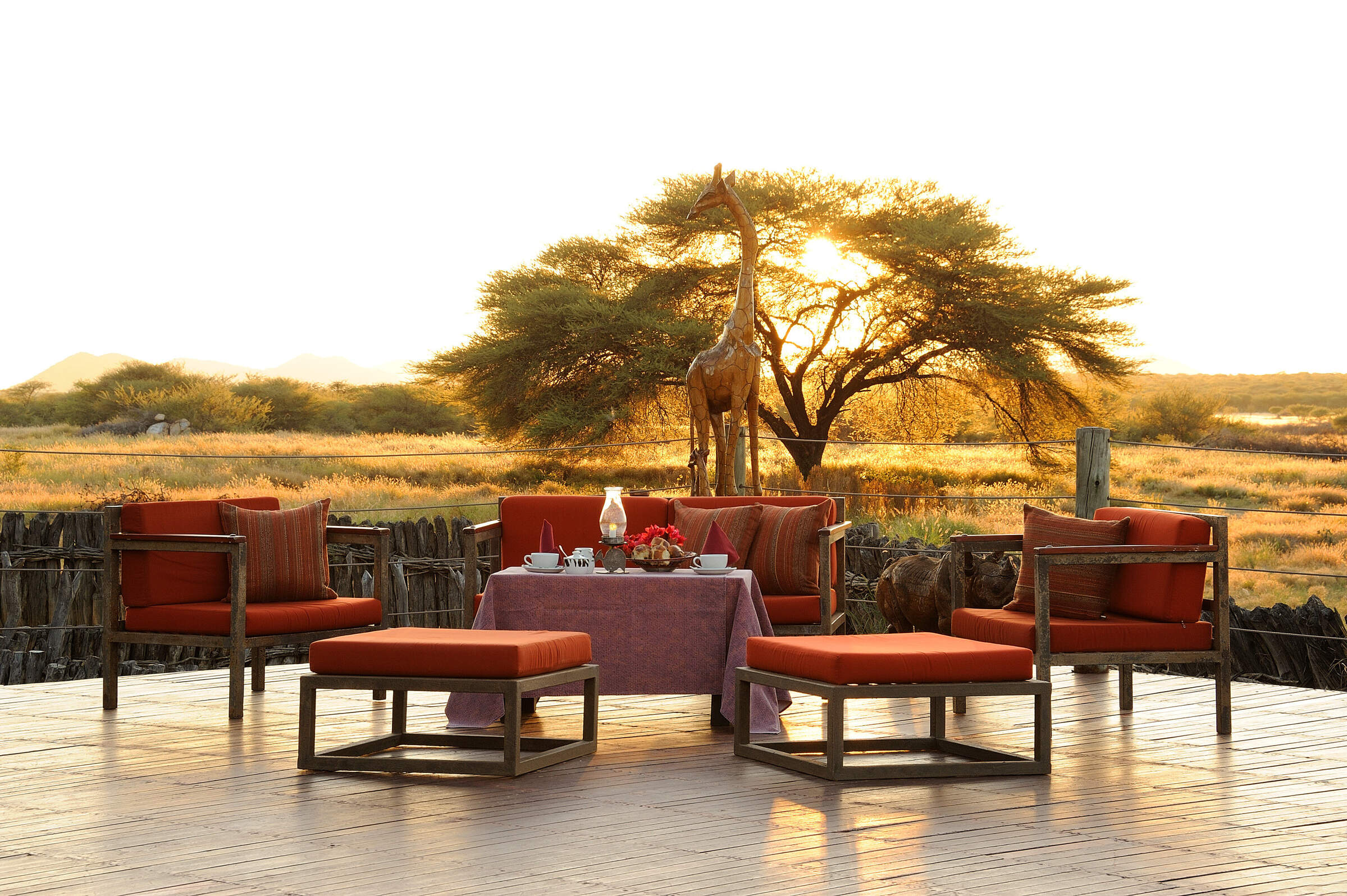
Frans Indongo Lodge
For a chance to spot some rare game species, Frans Indongo Lodge is an ideal stop over between Windhoek and the Etosha National Park.
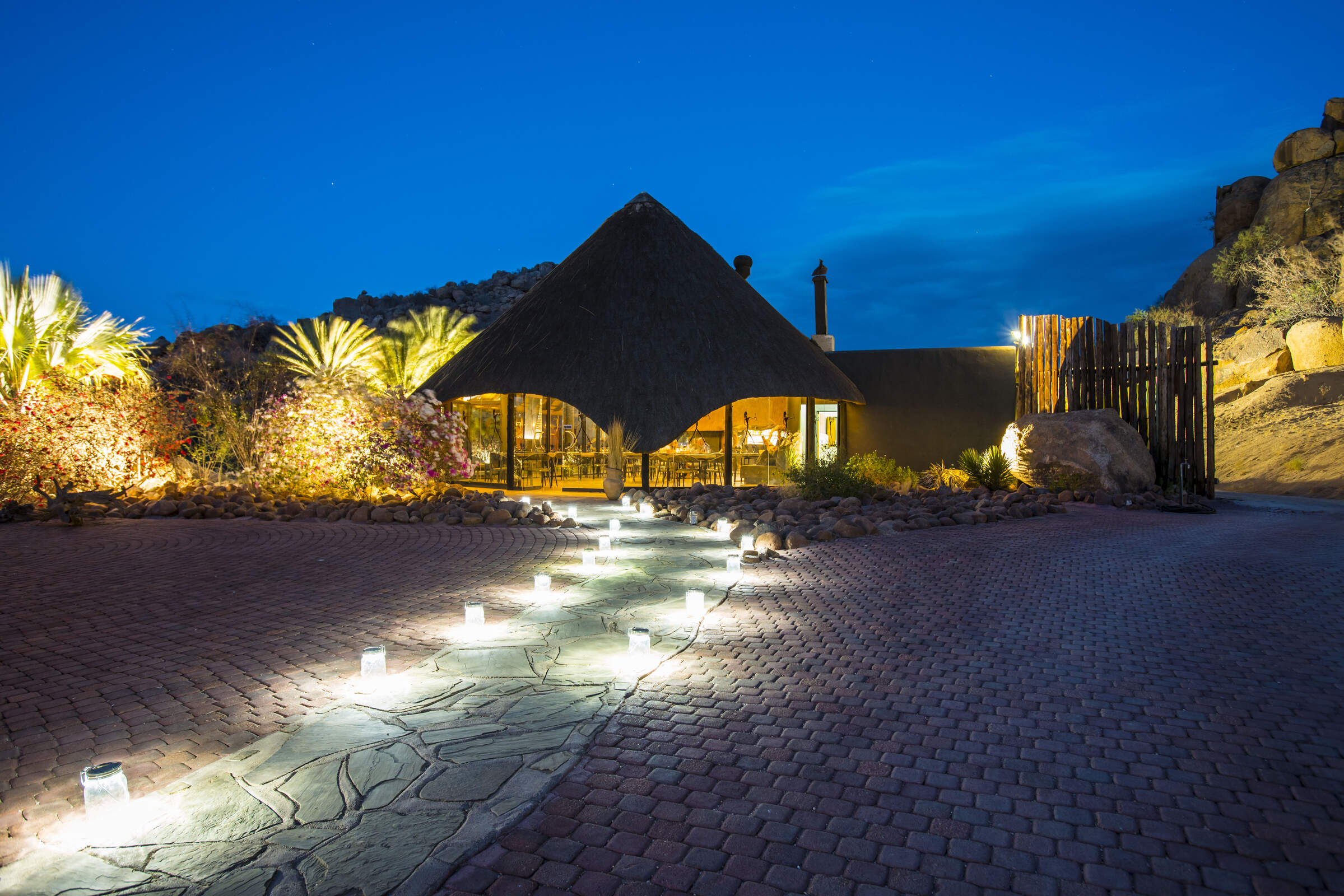
Ai Aiba Lodge
A convenient stop between Etosha and Windhoek,.Ai Aiba is a simple and relatively large lodge with plenty of great walking, and some spectacular San rock art.
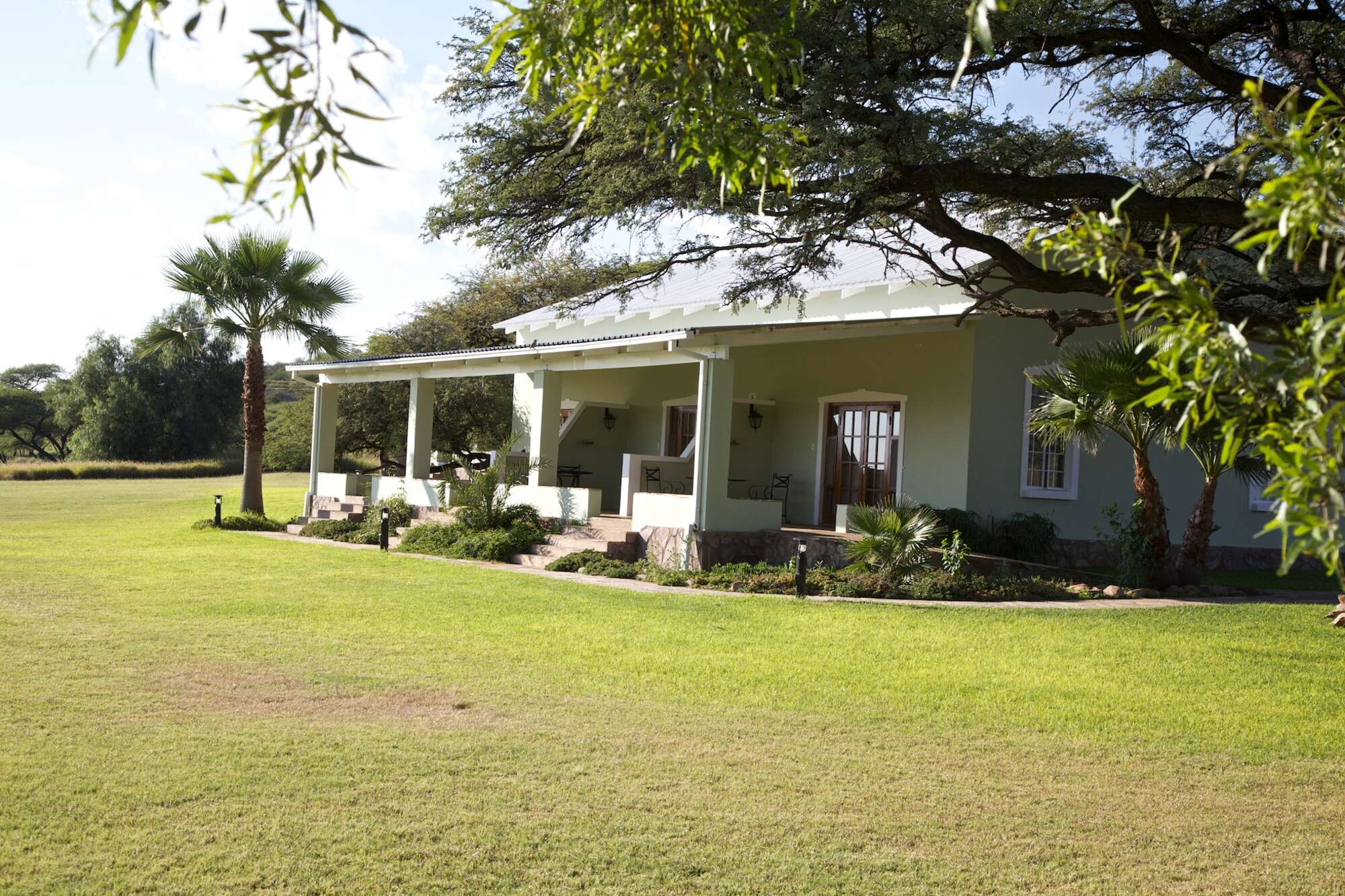
Ghaub Guest Farm
Ghaub Guestfarm is a charming guestfarm on the site of an old mission station, in an unusually verdant patch of Namibia.
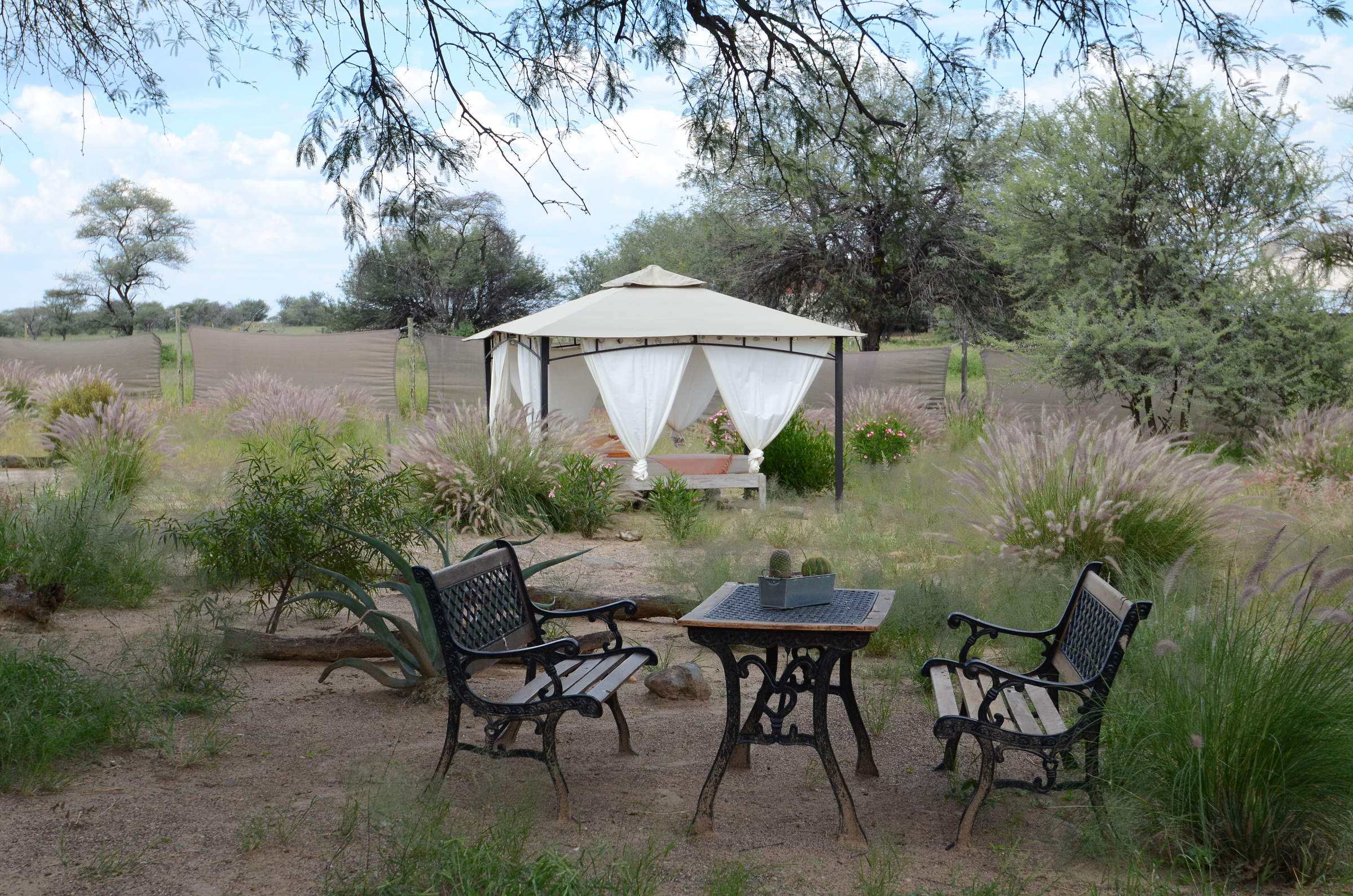
Elegant Farmstead
A stylish and peaceful lodge, The Elegant Farmstead is a relaxing and comfortable place to break the journey between Windhoek and Etosha.
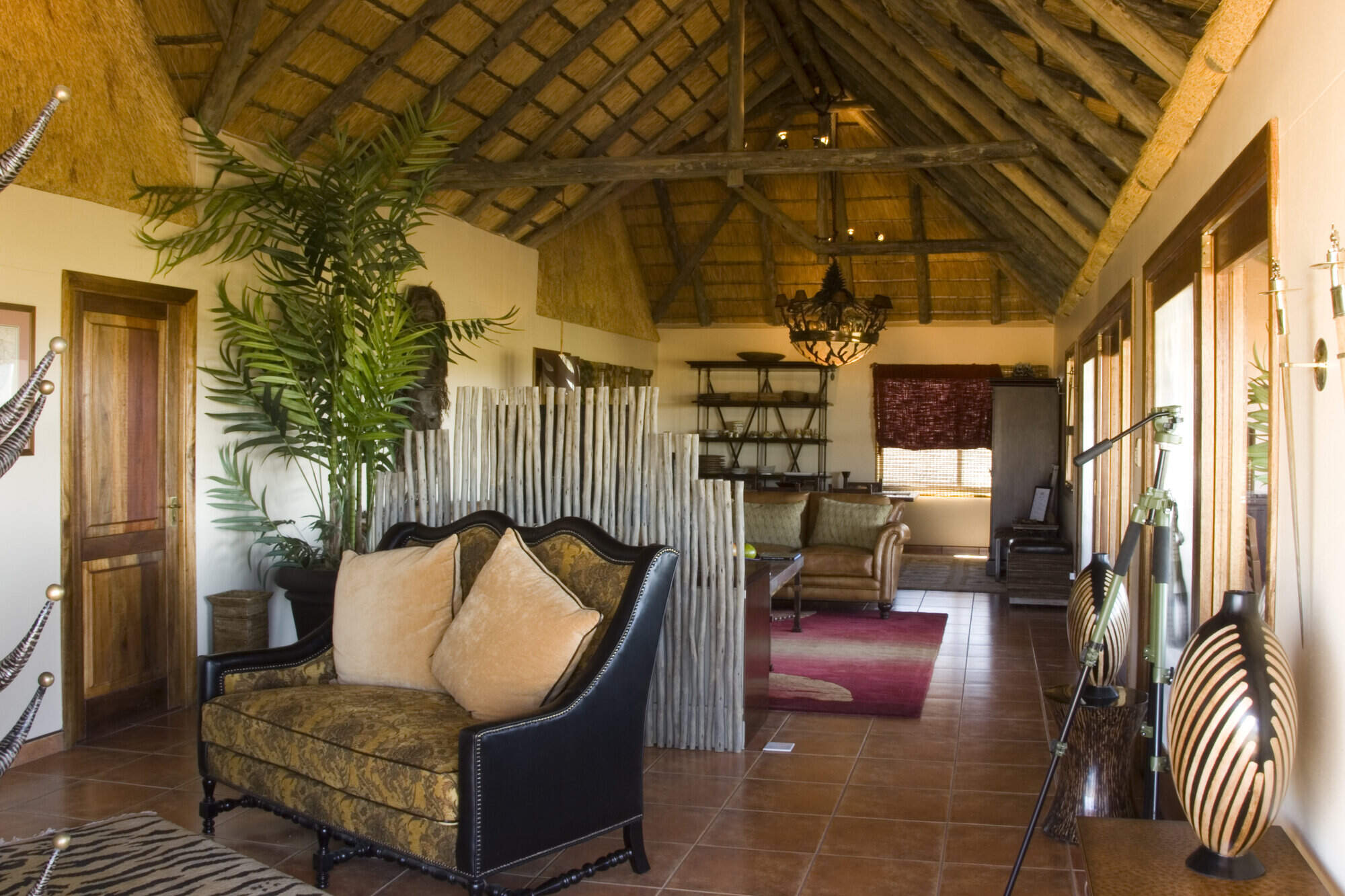
Cheetah View
Cheetah View Lodge offers guests the chance to see cheetahs at close range and to learn about the work of the Cheetah Conservation Fund.
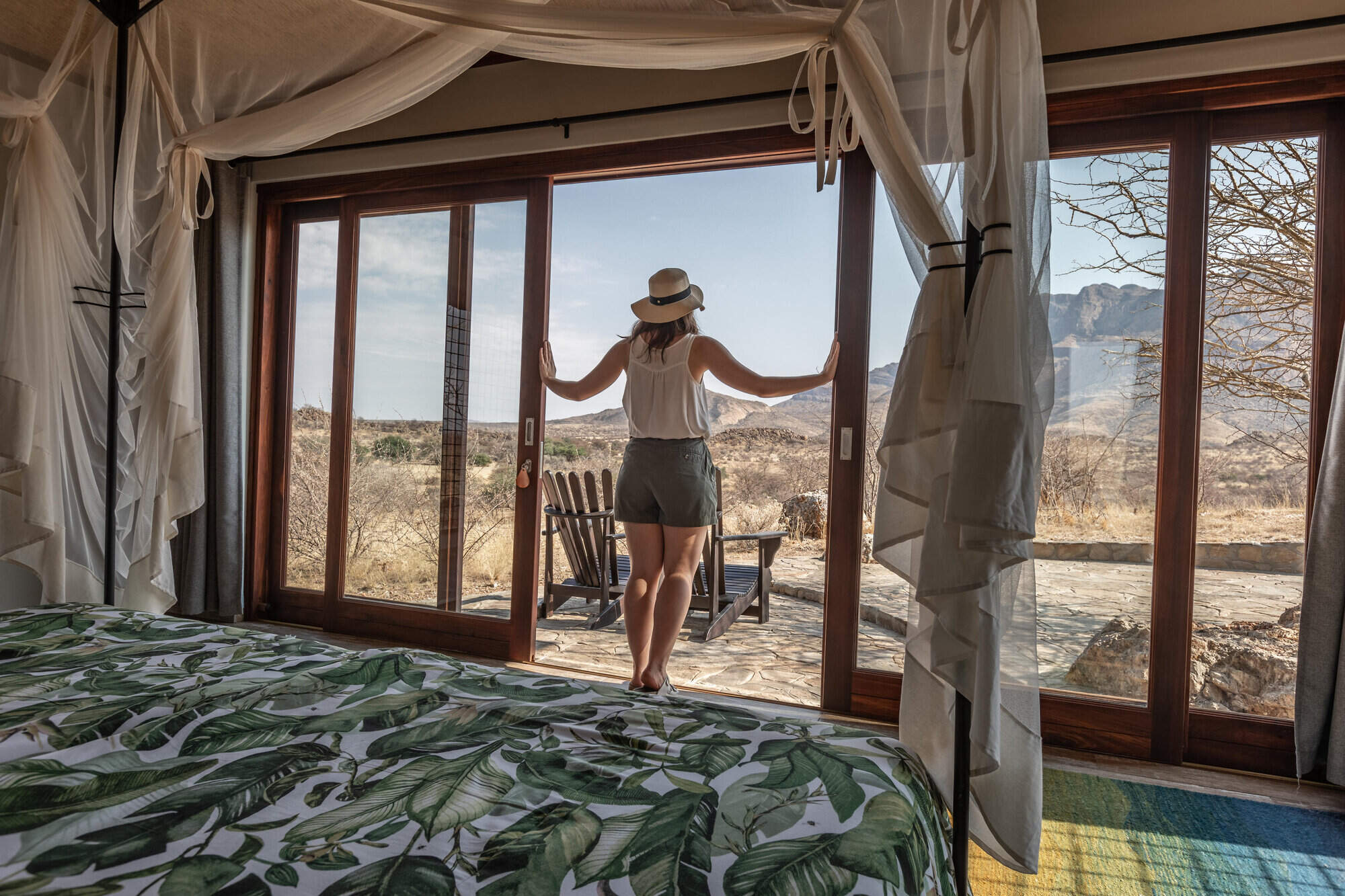
Hohenstein Lodge
Hohenstein Lodge is situated south of the Erongo Mountain Range. Each of its ten chalets has been built to make the most of the panoramic views.
When to go to Central Highlands
Our month by month guide: What it's like to visit Ondudu in Central Highlands
Jan
Feb
Mar
Apr
May
Jun
Jul
Aug
Sep
Oct
Nov
Dec
Central Highlands in January
The Central Highlands experiences the heart of the rainy season in January. The Erongo Mountains and Otavi Highlands see localised showers, creating a refreshing change in the landscape.
Days can be clear and warm, with temperatures around 30°C/86°F, while others bring spectacular thunderstorms. These rains can cause flash floods in ephemeral rivers, temporarily transforming the usually dry landscape. The greening environment makes a striking contrast, especially in the rocky terrains of Spitzkoppe and Brandberg.
Many birds in the region, including those in the Waterberg Plateau Park, are in full breeding plumage, and migrant species are abundant. Wildlife in areas like the AfriCat Foundation near Otjiwarongo may be more dispersed due to increased water availability, making sightings less predictable.
- Variable weather, hot with occasional rain
- Thunderstorms possible in the Erongo Mountains and surrounding areas
- Wildlife dispersed, harder to spot
- Birdlife spectacular in the Waterberg Plateau
- Fewer tourists, lower rates for accommodation
Our view
This is not a great time to visit
Weather in January
Central Highlands in February
February is typically the wettest month in the Central Highlands. The variation in weather is significant; areas like Okahandja and Otjiwarongo can experience heavy rains, while the Erongo Mountains might see more sporadic showers. Some days are clear and hot, while others bring cloudy skies and spectacular thunderstorms. These rains can make travel challenging, especially on unpaved roads to attractions like Spitzkoppe.
The landscape turns vibrantly green, particularly noticeable in the usually arid areas around Brandberg. This abundance of water and vegetation makes wildlife viewing in places like the Waterberg Plateau Park more challenging, as animals disperse widely. However, it's an excellent time for birdwatching, with many species raising their young and insects becoming more prevalent.
- Hot and humid with some rainfall
- Lush landscapes in Otavi Mountains
- Excellent birdwatching opportunities
- Wildlife viewing challenging but rewarding
- Few tourists, good deals on accommodation
Our view
This is not a great time to visit
Weather in February
Central Highlands in March
March usually sees the rains in the Central Highlands tapering off, and daily temperatures can spike to close to 40°C/104°F. The Erongo and Otavi Mountains may still experience occasional showers, but many days are clear with strong sunshine. Late afternoons might bring short, spectacular thunderstorms, particularly around higher elevations like Waterberg Plateau.
The landscapes across the region, from Okahandja to Otjiwarongo, are often at their most vivid green. This abundance of vegetation can make wildlife spotting more challenging in areas like the AfriCat Foundation, as animals have plenty of cover. However, it's an excellent time for hiking in the Erongo Mountains or exploring the rock art at Brandberg – though it’s recommended to hike in the early mornings to avoid the soaring temperatures and last of the summer storms in the afternoons.
Many birds and animals are finishing raising their young, making it an interesting time for nature observation.
- Less rainfall, though humid and hot
- Erongo Mountains ideal for hiking
- Animals well-fed after months of plentiful rainfall
- Migratory birds begin to depart
- Few tourists visit during March, so rates often low
Our view
A good time to visit, with pros & cons
Weather in March
Central Highlands in April
April in the Central Highlands central Namibia is dominated by dry weather, with decreasing chances of rain. Temperatures in areas like Okahandja and Otjiwarongo start to fall towards the end of the month, making daytime conditions pleasant for outdoor activities. The nights might have a slight chill, especially in higher areas like the Erongo Mountains.
The landscape remains verdant from the recent rains, creating beautiful scenery around attractions like Spitzkoppe and Brandberg. This is an excellent time for photography, with clear air and spectacular landscapes. Wildlife viewing at places like the AfriCat Foundation or Waterberg Plateau Park can be rewarding, with animals in great condition after the rainy season. However, finding big game can still be challenging as water remains widely available.
April offers good value for tourists, with many lodges still charging low-season rates.
- Cooler nights, pleasant daytime temperatures
- Easter brings a slight increase in visitors
- Wildlife more visible as vegetation thins
- Fresh air and green landscapes
- Great time for photography in Spitzkoppe
Our view
A good time to visit, with pros & cons
Weather in April
Central Highlands in May
By May, central Namibia starts drying out rapidly. Days are typically warm with crisp, clear mornings and blue skies. Evenings are cool, with temperatures potentially dropping below 10°C/50°F overnight. If the rains have been good, areas like the Erongo Mountains and Otavi Highlands remain green, but wildlife starts to concentrate around permanent water sources.
The air quality and clarity in the region can be amazing, making this an ideal month for photography at iconic locations like Spitzkoppe or Brandberg. This is an excellent time for hiking in the Erongo Mountains or exploring the Waterberg Plateau, with comfortable temperatures and increasingly good wildlife sightings.
Many lodges in the area still offer low-season prices, making May a great value month for visiting the area.
- Dry, warm days and cool nights
- Landscapes transition from green to gold
- Excellent visibility for wildlife viewing
- Moderate rates as high season approaches
Our view
A very good time to visit
Weather in May
Central Highlands in June
June brings dry conditions. Skies are blue and largely cloudless over areas like Okahandja and Otjiwarongo. Days are lovely and warm, but nights can be cold, sometimes approaching freezing in exposed areas like Spitzkoppe. Visitors should pack warm clothing for early morning activities, such as game drives at the AfriCat Foundation.
Wildlife viewing in the region, especially around Waterberg Plateau Park, follows dry-season patterns with animals congregating around water sources. The clear air makes this an excellent time for photographers to capture the dramatic landscapes of the Erongo Mountains or Brandberg.
Historically, June has offered lower rates, but with increasing popularity, some lodges now consider it part of their high season, so early booking is advisable.
- Clear, crisp days and cold nights
- Erongo Conservancy offers great game drives
- Stargazing opportunities in the Brandberg area
- Wildlife concentrates around water sources
- Moderate lodge rates, increasing number of visitors
Our view
A very good time to visit
Weather in June
Central Highlands in July
July in the Central Highlands offers reliably warm daytime temperatures above 20°C/68°F and excellent wildlife viewing opportunities. Rain is extremely rare, and clear skies provide perfect conditions for stargazing in areas like the Erongo Mountains. However, the occasional cold front can pass over the area, and nights can be very cold, potentially dipping below freezing in exposed areas like Spitzkoppe. Visitors should dress in layers and be prepared for chilly mornings and evenings.
As vegetation becomes sparse, game concentrates around water sources, making this an ideal time for wildlife viewing at places like the AfriCat Foundation near Otjiwarongo, or Waterberg Plateau Park. The dry conditions also make this a great time for hiking and rock climbing activities in the region.
Lodges typically charge high-season rates, and popular spots can book up well in advance.
- Dry days, cold nights in the Central Highlands
- Peak season for wildlife viewing begins
- European holidays bring more family travellers
- Higher rates, advanced bookings necessary
- Excellent time for hiking in Waterberg
Our view
A very good time to visit
Weather in July
Central Highlands in August
August marks the height of winter in the Central Highlands. Expect cloudless skies and warm sun during the day, but nights can drop to freezing in exposed areas like Spitzkoppe or the Erongo Mountains. Visitors should bring warm clothes for chilly mornings and evenings, especially for activities like early game drives.
The landscape is at its driest, with golden-brown vegetation dominating. This makes wildlife viewing excellent, particularly in areas like Waterberg Plateau Park or the AfriCat Foundation near Otjiwarongo, as animals congregate around remaining water sources.
August is one of the most popular times to visit the Central Highlands, especially for families. Attractions like Brandberg's rock art sites or hiking trails in the Erongo Mountains are particularly appealing in the cooler weather. Early booking is essential for the best lodges.
- Warm days in the sun, very cold nights
- Spectacular stargazing in Erongo Mountains
- Wildlife viewing at its best in the region
- Peak season rates, limited availability
Our view
Fantastic: the very best time to visit
Weather in August
Central Highlands in September
September in the Central HighlandsCentral Highlands brings blue, cloudless skies and fantastic wildlife viewing opportunities. Rain is almost unheard of, and as the month progresses, both days and nights get warmer. Daytime temperatures in areas like Okahandja and Otjiwarongo can reach the low 30s °C/80s °F .
The air becomes dustier, which can create hazy conditions for photographers capturing the dramatic landscapes of Spitzkoppe or the Erongo Mountains. Wildlife viewing is at its peak, with animals congregating around remaining water sources. This makes September an excellent time to visit places like the AfriCat Foundation or Waterberg Plateau Park.
It's one of the most popular months for visitors, especially safari enthusiasts, and lodges charge high-season rates. Early booking is advisable for prime locations.
- Warm days, temperatures rising steadily
- Landscapes golden brown, great for photos
- Excellent month for wildlife observation
- High season rates, book well in advance
- Himba cultural tours available near Opuwo
Our view
Fantastic: the very best time to visit
Weather in September
Central Highlands in October
October is typically the hottest and driest month in the Central Highlands. Temperatures build throughout the month, with daily highs potentially exceeding 40°C/104°F in areas like Okahandja and Otjiwarongo. Despite the heat, the low humidity makes conditions bearable.
This is the peak of the dry season, making it an excellent time for wildlife viewing in places like Waterberg Plateau Park or the AfriCat Foundation, as animals gather around scarce water sources. However, dust and occasional smoke can make the air hazy, challenging for photographers. The Erongo Mountains and Spitzkoppe offer dramatic, parched landscapes.
October is popular among wildlife enthusiasts and commands peak-season prices. Towards the end of the month, visitor numbers may decrease slightly, offering a window for last-minute bookings.
- Hot and dry throughout Central Highlands
- Prime time for game viewing in reserves
- Waterberg Plateau offers scenic hikes
- Peak rates, limited availability at lodges
- Spitzkoppe ideal for rock art enthusiasts
Our view
A very good time to visit
Weather in October
Central Highlands in November
November in the Central Highlands can be unpredictable. Mornings are often hot and cloudless, but afternoons may bring cloud cover and cooler temperatures. Areas like Okahandja and Otjiwarongo might experience spectacular late-afternoon thunderstorms as humidity builds. These storms are typically localised and may be absent from more arid areas like Spitzkoppe. Places receiving good rain, such as the Erongo Mountains, quickly turn green, bringing a sense of renewal to the landscape.
This is an exciting time for wildlife, with many mammals giving birth. Once rains arrive, wildlife in areas like Waterberg Plateau Park becomes more dispersed, making game viewing more challenging. However, November is excellent for birdwatchers, with migrant species arriving in breeding plumage, especially noticeable in the diverse habitats of the Central Highlands.
- Variable weather, possible early rains
- New vegetation growth begins if it rains
- Wildlife viewing good in Erongo region
- Shoulder season, rates become more moderate
- Bird watching excellent as migrants return
Our view
A good time to visit, with pros & cons
Weather in November
Central Highlands in December
December marks the start of the rainy season in the Central Highlands and is one of the hottest months. In areas like Okahandja and Otjiwarongo, clear mornings often give way to building clouds and occasional spectacular thunderstorms. These rains are generally welcomed, refreshing the parched landscapes of places like the Erongo Mountains and Spitzkoppe. Even short showers can trigger a rapid greening, providing food for young animals.
Wildlife tends to disperse widely, which can make game viewing at locations like the AfriCat Foundation or Waterberg Plateau Park more challenging. However, many birds are breeding, sporting their most colourful plumage.
The holiday season can make popular attractions and accommodation options busy, especially in cooler areas like the Erongo Mountains. Visitors should book well in advance and be prepared for potential weather-related changes to their plans.
- Hot with possibility of rain showers
- Landscapes green where rain has fallen
- Otavi Mountains offer scenic game drives
- Best time for birding enthusiasts
- Holiday season brings more local tourists
Our view
This is not a great time to visit
Weather in December

Looking for inspiration on where to travel next?
Visit our trip chooser to explore your options and find inspiration for your perfect African adventure
Inspire me